Georgia’s Cabin Bluff: Bobwhite Quail at America’s Oldest Hunt Club
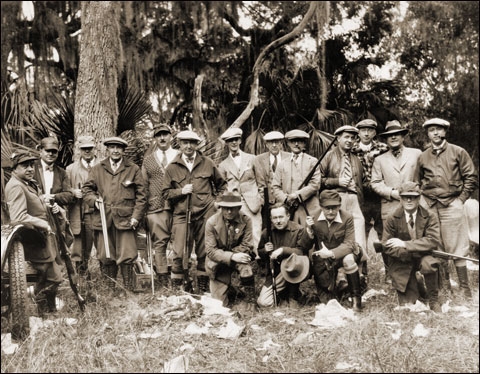
As the oldest hunting club in America, Cabin Bluff exemplifies that celebrated down-home, Low-Country hospitality duly expressed when I received a pecan pie on the house for the ride home.
Under the recent arrival of Chef Terrance Freeman, the cooking at Cabin Bluff proved so consistently delicious that the pecan pie served for dessert with dinner turned out to be the best I ever tasted. After I had mentioned it to the staff on my final night there, the kitchen wrapped the pie save for that single slice and graciously gave it to me.
The good Georgia folks of Cabin Bluff seem to truly love the place with a devotion rarely seen anymore. As a Yankee, I attribute their generosity of spirit to that legendary Southern geniality. But Cabin Bluff’s integrity runs deeper toward the culture of a private hunt club, where you live in a cloistered idyll steeped in Southern grace.
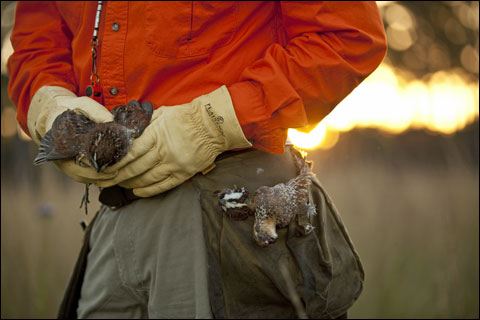 The author bagged plenty of bobwhite quail like this one at Cabin Bluff.
The author bagged plenty of bobwhite quail like this one at Cabin Bluff.In fact, for most of the time since its establishment in 1928, Cabin Bluff operated as a private hunting and fishing club in Woodbine, Georgia. The property originally hosted the Camden Hunt Club founded in 1827, often credited as being the first members-only hunting club in the US. Founded by the prominent Floyd dynasty, the club hosted hunting parties and dug-out boat races (with purses upwards of $10,000) for families of the great plantations and their guests.
Even now, when you enter the riverfront compound, the long driveway gradually reveals the period mocha-colored guest cabins with their dark brown roofs beneath sprawling live oaks and longleaf pines lush with Spanish Moss – conveying a timeless sanctity: a secret retreat held dear by a fortunate few. Cabin Bluff was so hush-hush that most locals had never heard of it.
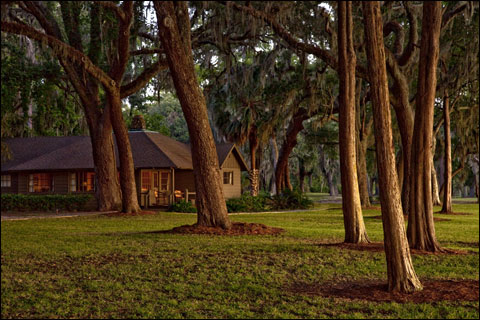 A historic guest cabin on the Cabin Bluff compound.
A historic guest cabin on the Cabin Bluff compound.Beginning in 2010, Cabin Bluff opened the property to outside guests in the wake of a corporate restructuring. Cabin Bluff had been jointly owned by real-estate developer Sea Island Corporation and pulp and timber giant Mead Westvaco. Under their stewardship, Cabin Bluff had been reserved for corporate guests and functions. But after Sea Island filed for bankruptcy in 2010, Mead Westvaco assumed full ownership and decided to give it a go as a public destination that could accommodate only 40 guests in the seven cabins and 20 private rooms. In addition, the 1,700-square-foot conference center is proving a big attraction for companies.
With an eye towards providing the ultimate in hunting experiences, Cabin Bluff had applied for the Beretta Trident Program and received a single Trident for upland birds with its membership in March 2011. As a point of reference, the Beretta Trident Program recognizes only five percent of destinations worldwide. The Beretta Trident Program evaluation system takes into account everything from the hunting to the food to the accommodations.
Cabin Bluff occupies 24,000 secluded acres, although the entire tract owned by Mead Westvaco is more than 64,000 acres and is primarily used for timber. The property is bounded by the Crooked River, the Satilla River and the Cumberland River. Guests can participate in sporting clays, five stand, fishing, boating, golf, and hunting for wild boar, deer and turkey. But I had visited Cabin Bluff for its 1,500 acres of pristine bobwhite quail habitat.
 The larger Mead Wesvaco tract that is home to Cabin Bluff is virtually surrounded by water – making for excellent fishing a magical Low Country atmosphere.
The larger Mead Wesvaco tract that is home to Cabin Bluff is virtually surrounded by water – making for excellent fishing a magical Low Country atmosphere.I had arrived in the evening and was assigned to a second-story, four-bedroom suite in a chalet, each of the bedrooms with its own private bathroom. The décor was rustic and masculine with wood paneled floors, walls and ceilings. Overstuffed leather furniture and golden lamp light enhanced the warm feeling of the wood. The spacious common living room hosted a stone fireplace. Split wood was stacked on the front porch, which provided a view of the Cumberland River. Through the open windows, a constant breeze rustled the surrounding trees in a mantra of the South.
As though to freeze time, the suite showcased a series of photos of club members from the 1920s lounging around the property in their hunting outfits. The pictures were haunting – calling you back in time. They appear throughout Cabin Bluff, including several of President Calvin Coolidge in a pale, wide-brimmed Stetson enjoying the property.
 Historic images of Cabin Bluff populate the buildings.
Historic images of Cabin Bluff populate the buildings.The next morning started with breakfast in a cozy, historic dining room that fronted a large kitchen. The cook, a woman who had been at Cabin Bluff for decades, mixed up luscious blueberry pancakes with real maple syrup, bacon, sausage and eggs.
Afterwards, I was met by Chuck Dean, the Quail Supervisor at Cabin Bluff. Mr. Dean’s exuberance for his job was readily apparent. He explained that Cabin Bluff’s bird-dog training emphasized positive reinforcement. He felt that method was the best way to reduce pressure on the dogs and improve their performance. It worked.
Carrying my 12-gauge Beretta Silverhawk, a fine specimen made in 1960, and shooting one-ounce, number eights , we started hunting for bobwhite quail among the Low-Country landscape of oak trees adorned with Spanish Moss, slash pines and hickory trees. Overcast skies carried a wind aromatic of pines, salt marsh and flowing rivers.
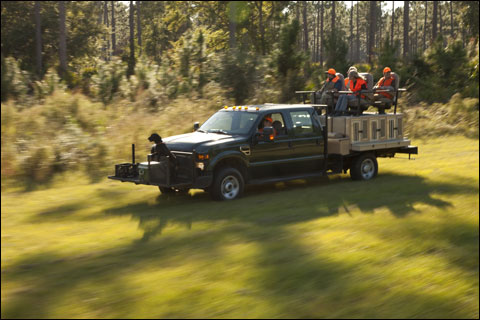 Riding out to some of the 1,500 acres of bobwhite quail hunting property at Cabin Bluff.
Riding out to some of the 1,500 acres of bobwhite quail hunting property at Cabin Bluff.With the temperature perfect for hunting, the dogs relished their work flushing birds. Cricket, an English Setter, and Billy, an English Pointer, worked the palmetto stands like superheroes bursting through the undergrowth. Between dog commands, Mr. Dean provided excellent company: knowledgeable, cordial and funny.
After moving a few times during the morning to different fields it was back to the compound for lunch. This time I ate in a small sunroom of the lodge. The lodge dates back to the origins of Cabin Bluff. Look at some of those old photos and you can match up the fireplace, the doors and other elements. Of course, it had been modernized over the years, but one distinct novelty that endures is the 13-foot alligator mounted to the rafters that had been shot by former Cabin Bluff owner, Alfred Jones, Sr., on his honeymoon in 1930.
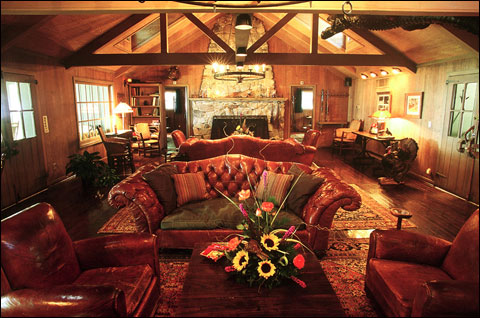 The lodge at Cabin Bluff.
The lodge at Cabin Bluff.Looking out onto the river, I savored the hearty broccoli and cheese soup laced with sherry. Dessert was bread pudding chunky with apples, dates and other fruits and nuts that added crunch and sweetness.
For our afternoon quail hunt, Mr. Dean brought out two English Pointers, Dot and Runt. The birds flushed like mad, bringing out of the best the Beretta Silverhawk. I had bought the gun a few years ago for $1,000 from a fellow member of my gun club for hunting over dogs. In absolutely mint condition, it has 26-inch barrels, choked improved cylinder and modified, with a single trigger and that distinctive polished silver receiver that contrasts with the gun’s exceptional dark walnut. A humble shotgun by most standards, there’s something about it that brings out the best in me – the fit, the trigger pull, its balance… probably all of it. Regardless, I have made some incredible bird shots with that gun and continued to do so at Cabin Bluff as the dogs flushed birds throughout the day under a threatening sky that reflected a silver-lure light from the rivers. Mr. Dean and his excellent dogs rewarded me with a total bag of 16 birds.
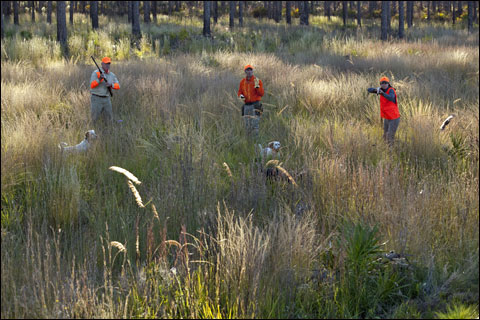 A great moment of bird hunting at Cabin Bluff.
A great moment of bird hunting at Cabin Bluff.Cocktail hour was soon upon me, leading into a mixed grill dinner at the Coolidge Tavern, which is easy to spot at night from the enormous fire in the pit near the front door. Like other buildings at Cabin Bluff, Coolidge Tavern has a story. It begins at the bar, with an enormous photo of President Coolidge at Cabin Bluff over the top-shelf offerings. I discovered later that the structure had originally served as a maintenance building. You’d never know it now. There was comfortable seating, a big-screen TV and an open kitchen. Through the front glass doors you can see the fire pit blazing. I had shared a bottle of 2007 Duckhorn Merlot with my companion, and then we walked out to the pier on the Cumberland River where rods and bait were waiting.
Morning started with a big breakfast followed by a round of sporting clays. The 10-station course at Cabin Bluff wends though the trees, with about half the presentations overlooking Shellbine Creek. The original course had been fine-tuned by the folks from Beretta Trident, with a few challenging targets sweeping wide over the creek in a spectacular display. A tour of the property ensued, taking plenty of back roads where wild hogs were clearly visible in the distance. We stopped at a secluded cemetery that had belonged to a former river community long gone.
And so it was that particular night with its enormous fried catfish dinner and all the sides that the famous pecan pie arrived, ready for the drive home the next day.
 Fishing the Cumberland River from the dock at Cabin Bluff.
Fishing the Cumberland River from the dock at Cabin Bluff.I’ll freely admit that I didn’t take full advantage of Cabin Bluff’s hunting and fishing. But there are plenty of opportunities to combine a quail shoot with a hog hunt, trout fishing in the river with five-stand, golf with sporting clays, swimming laps in the beautiful pool with a nature hike.
You can also visit nearby historic Cumberland Island. As a designated National Seashore, the only inhabitants are the descendants of early property owners. Cumberland Island is home to wild mustangs whose blood lines date back to the survivors of sunken Spanish galleons over 500 years ago.
Still, it’s the bobwhite quail that linger in your memory. There’s an ephemeral quality to the landscape, the river light that filters through the Spanish Moss, the black-and-white photos of people who hunted the land before you. There are plenty of places to shoot quail in the south, but Cabin Bluff is the most magical of all.
Irwin Greenstein is the Publisher of Shotgun Life. You can reach him at letters@shotgunlife.com.
Useful resources:
The Cabin Bluff web site
The Beretta Trident Program web site

Irwin Greenstein is Publisher of Shotgun Life. Please send your comments to letters@shotgunlife.com.


Comments